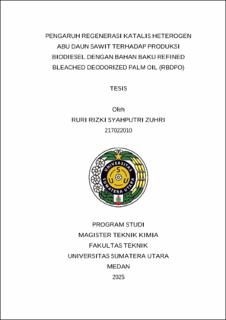Pengaruh Regenerasi Katalis Heterogen Abu Daun Sawit terhadap Produksi Biodiesel dengan Bahan Baku Refined Bleached Deodorized Palm Oil (RBDPO)
The Effect of Regeneration of Heterogeneous Catalyst from Palm Leaf Ash on Biodiesel Production Using Refined Bleached Deodorized Palm Oil (RBDPO) as Feedstock

Date
2025Author
Zuhri, Ruri Rizki Syahputri
Advisor(s)
Manurung, Renita
Tambun, Rondang
Metadata
Show full item recordAbstract
Currently, energy needs for fuels such as transportation and industry almost
entirely come from fossil fuels, including fuel oil (BBM). Meeting this fuel need can
be done using renewable alternative fuels, one of which is biodiesel. Biodiesel has
physical properties similar to conventional fuel, is biodegradable, less toxic, and
has a combustion emission profile that is more favourable than conventional diesel
fuel. Palm oil (Refined Bleached Deodorized Palm Oil or RBDPO) can be used as
a raw material for biodiesel production. In biodiesel production, biomass-based
heterogeneous catalysts are more desirable because they can be used repeatedly
and reduce production costs. One of the heterogeneous catalysts widely studied in
biodiesel production is the sodium silicate catalyst (Na2SiO3), obtained by reacting
Na metal with a silica matrix from biomass. Palm leaves can be used as a source
of silica matrix because palm leaves contain 70.11% SiO2 and have not been used
optimally. This research examines the effect of Na2SiO3 catalyst regeneration from
palm leaf ash on RBDPO-based biodiesel production. This research consists of 4
stages: preparation of SiO2 from palm leaf ash, synthesis of palm leaf ash catalyst,
application of palm leaf ash catalyst, and studies of catalyst reusability and
regeneration in biodiesel production. Preparation of SiO2 from palm leaf ash at a
temperature of 700°C for 3 hours, followed by extraction using 1 M HCl solution.
Synthesis of palm leaf ash catalyst was carried out with variations in the
NaOH:SiO2 molar ratio of 1:1, 1.5:1, 2 :1, and 2.5:1. Biodiesel production was
carried out with a molar ratio of RBDPO:methanol of 1:12, a reaction temperature
of 65°C, and a catalyst amount of 2% (w/w) of the mass of RBDPO used. The
reusability study of the catalyst was carried out until two layers did not form. The
catalyst regeneration was carried out using variations in the catalyst:methanol
solvent ratio of 1:3, 1:4, 1:5, and 1:6 (m/v). In this research, the RBDPO used had
an FFA content of 1.14% and a moisture content of 0.06%. The best biodiesel yield
was obtained with a NaOH:SiO2 ratio of 1.5:1, namely 72.47%, with an ester
content of 97.29%. The resulting palm leaf ash catalyst has a heterogeneous surface
with many pores and contains 18.9% Na. Characterization using FTIR shows the
presence of the Si-O-Na functional group at wave numbers of875.93 and 913.34
cm-1, which indicates the successful synthesis of the Na2SiO3 compound on a
catalyst. BET-BJH characterization shows that the catalyst produced is classified
as a mesoporous material, with a surface area of6.43 m2/g, pore volume of 0.02
cc/g, and pore size of 5.31 nm. Reusing the catalyst reduced the biodiesel yield to
62.39% in the third use. Catalyst regeneration can improve the morphology and
elemental composition of the catalyst, with a biodiesel yield of 90.84%.
Collections
- Master Theses [142]
